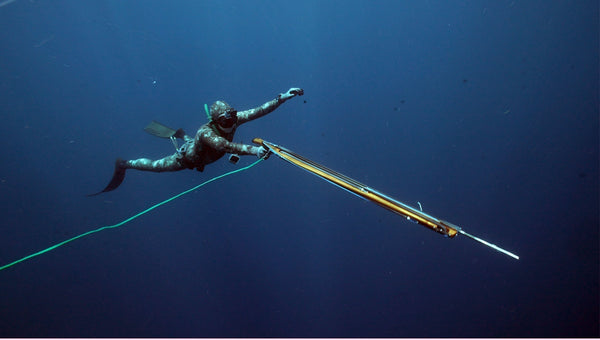How to choose your first speargun: A Comprehensive Guide
Buying your first speargun is exactly like your first love. At first, you adore it and can't spend enough time together—you love rolling in the deep. But over time, you realize you made a huge mistake. You start noticing things: the ugly parts, the awkward moments, and the fact that you have no idea how to handle it in tight spaces. You thought it would be a low maintenance, beautiful weapon, but now it’s just a pain in the ass and costing you heaps of money.
This situation could have been avoided if you had read this blog. Although I have no idea how to help with your love life, I can help with the speargun part.
Jokes aside, the best first speargun is both an incredibly important and incredibly difficult decision. There is so much info around types, brands and configurations that it easily becomes overwhelming.
We've been diving, spearfishing and testing spearguns since we were kids. We have also been teaching beginners for years and we know the common mistakes and thus things to avoid.
Below is literally decades of knowledge condensed into a practical and informative guide that can help anyone find the best speargun for your needs.
Disclaimer: I mention a heap of brands in the below article BUT we do not receive any commission for directing you to purchase from them. We do work closely with the Kraken Spearguns Team and they provide us with guns from our school. However, our recommendation of them and decision to work with them is because we think they are the BEST. Otherwise, we recommend it based on personal experience. If you do work for one of these companies, please email us. We would LOVE to forge a relationship with you.
Let’s go.
Who is this guide for?
This guide is aimed mostly for people buying a speargun for the first time.
As such, we've made the language as simple and easy to understand as possible while still delivering all the essential info you need.
Even if this isn't your first speargun, there may be some tips and tricks in here that you didn't know.
We're amazed at how much we learn even after decades of spearfishing and diving.
Perhaps you will be too upon joining one of our spearfishing trips!
Anatomy of a speargun
While the different types of spearguns do vary when it comes to parts, most spearguns, whether band-powered, pneumatic or roller, have similar components.
- Barrel: The barrel is the main body of the speargun that holds all other parts together. It can be made of wood, aluminum, fiberglass, carbon fiber, or a mix of these materials.
- Muzzle: The front part of the barrel where you load the spear and attach your rubber bands. There are two types of muzzle: open muzzle and closed muzzle
- Band: This determines how much power your speargun packs. These are usually made of rubber latex and come in various lengths, widths and strengths
- Spear/shaft: The spear that’s loaded into the speargun and shot at the fish.
- Handle: The grip where you hold the speargun while aiming and shooting
- Trigger mechanism: This is what releases the spear when you pull the trigger
- Reel: A device attached to the gun that holds a line that is then attached to the end of your spear. More on Reels below.
- Safety: A mechanism that prevents the speargun from accidentally firing. Spoiler alert. I hate safeties. More details below.
Types of spearguns
Polespears/handspears
Ok, so these aren't technically a speargun, but they're still worth mentioning.
- Polespears or handspears consist of a rubber band or a loop attached to the end of a pole.
- They're simple, lightweight and cheap, however, they are not the most efficient or effective method for catching fish
- Beginners will really struggle when using a polespear as you need to get a lot closer to the fish. This is something that comes with experience and time in the water.
- With this in mind there is an argument to be made that starting using a polespear encourages really efficient hunting technique- making you a better spearo in the long run. While this is true, in my opinion it will take WAY too long to see results as this is a super challenging method of hunting. You will have to persist for years before seeing any good results. In my opinion it's better to start with a more forgiving traditional band gun, focus on enjoyment before exploring using a polespear.
- If you are more advanced, you may enjoy the challenge of using polespears due to the super close distance you have to get to fish.

Traditional Band Spearguns
These are the main types of spearguns you'll see mostly in a spearfishing shop or browsing an online store. They're the default speargun for most divers.
- Band-powered means that the gun uses rubber bands to shoot the spear towards the fish.
- You simply load the spear into the gun, pull back the bands and lock them in place, aim and fire
- The length of the speargun usually ranges from 24 to 60 inches (60 to 150 centimetres)
- Longer guns provide more power and range, while shorter guns are easier to maneuver in tight spaces.
- The more bands added, the more power and speed the gun will have
- More bands also means more recoil and a stronger kickback
- Band-powered guns strike a great balance between effectiveness and ease of use, which makes them ideal for beginners, casual divers and high level divers alike.
Pneumatic spearguns
Pneumatic spearguns use compressed air to propel the spear. They're considered more powerful and accurate than band-powered guns, but they do require a bit more technique and maintenance.
- These guns have a hollow tube that holds the spear and an air chamber at the end
- Pneumatic guns have minimal recoil and great accuracy
- Their power is limited by the amount of air that can be pumped by the diver
- Full disclosure, I have never actually used one of these guns, but to me they seem overly complicated and difficult to use. Plus fixing them seems like a nightmare. One thing I love about traditional band guns is that if you bring spares of each component (of which there are few) there is not much that can go wrong that will ruin your trip.
Reel spearguns
More advanced divers sometimes opt for spearguns that have a reel attached to them. This eliminates the need for a float and floatline. I have a love hate relationship with reel guns but to be clear, as your first gun- DO NOT BUY A REEL GUN. They are WAY more dangerous. Save it for later on when you are more confident and competent. Here's why:
- Reel guns are prone to jamming, this means that the line can get stuck and will not exit the reel when fighting a fish. This is especially true when you are new to spearfishing and don't know how to rig it correctly.
- Another downside is you can't drop a reel gun. I mean you could, but you would never see it again. Traditional float and float line set ups can be dropped at any time without the risk of losing them as they are tethered to the surface by a float. Dropping your gun is a good strategy in a lot of scenarios, like when you get the spear stuck or when you shoot a large fish. We teach you all about this in our beginner spearfishing course→ see here: https://aquaticapes.com/pages/spearfishing-course-in-bali
- Many spearos have died from having something happen to their reel gun meaning the line cant exit the reel and then they are stuck fighting a powerful fish all on their own. Human nature is you think you can win that fight but a large fish will easily drown you, especially when you don't want to drop your gun and risk losing it forever.
- Floats also protect you from boat traffic which is usually a big issue in beginner friendly areas.
- This is a complex topic for another blog post but safety is most important when you start. Focus on enjoyment, catching and eating fish and avoid worrying about losing your new gun or worse drowning while trying to save it. This is best done with a float and floatline.
Roller spearguns
A roller speargun is a variation on the band-powered speargun, but features a roller mechanism that the bands roll over. This design allows for more power and range without adding additional bands. These are recommended for advanced divers hunting large species. Not as a first gun.
- Roller guns are generally shorter than standard band-powered guns
- The roller mechanism also reduces recoil but makes loading difficult. There are many spearos who buy a roller gun because they think they look cool but then hate themselves because their bodies are so sore after diving from constantly loading the gun. I am in this camp. I bought a rollergun as I thought they were great but have since swapped back to traditional band guns.
- The power from rollers also makes spears more likely to get stuck when hunting in areas around caves and rocks
- They are also more expensive than band-powered guns.

Factors to consider when buying a speargun
Budget
A good gun can range from as low as $50 to upwards of $2,500. Here are some things for consideration.
- Keep in mind that more expensive doesn't always equal better, especially for beginners HOWEVER
- I have an opinion that others may disagree with but I think it's best to spend some money and get a high quality gun the FIRST time. The old saying goes that ‘the cheap man pays twice’ and this has never been more true than with spearguns. Get a high quality traditional band gun your first time and it will last you a lifetime. Don't buy a cheapo and replace it with the one you would have bought anyway a year or so later.
Skill level
Since you are a beginner, aim for a basic band-powered speargun that fits your needs.
- Talk to other divers and see what brands they recommend, or poke your head into your local dive shop. If you are in Australia Adreno has a great selection and gives fantastic advice. All the crew members are spearos and would be happy to point you in the right direction. Check them out here adreno.com.au
- If you do end up upgrading, keep your first gun for dive buddies who want to join in on the fun- never dive alone.
Length
The length of the spear is directly related to its power and range. Longer spears have more power and range, but they may also be harder to maneuver in tight spaces. They are also harder to load.
- Shorter spearguns are great for diving close to shore in rocky areas or reefs where you may need to navigate around obstacles, but they have limited range. They are also much easier to load for those who are young, short or have short arms.
- Longer spearguns are better suited for open waters with less obstructions or when targeting larger fish that require more power and range. They are also suited to bigger humans.
- Consider water resistance too, as longer and bulkier models create more drag that makes them harder to move underwater
- As a general rule, the best all rounder in my opinion is a 110-120cm gun. This is what I use for 90% of my diving.
- As a rough guide I recommend the following. Please be aware that this is a huge simplification but can be used as a starting point.
70-80cm Gun
|
Age |
Height |
Weight |
Target Species |
|
16 or below |
150cm or less |
50kg or less |
Small reef species |
90cm gun
|
Age |
Height |
Weight |
Target Species |
|
16-18 |
150-160cm |
50-60kg |
Small reef species |
100cm gun
|
Age |
Height |
Weight |
Target Species |
|
18+ |
160-165m |
60-70kg |
Small reef species |
110 cm gun
|
Age |
Height |
Weight |
Target Species |
|
18+ |
165-170cm |
70-80kg |
Medium sized reef species and small pelagic species |
120cm gun
|
Age |
Height |
Weight |
Target Species |
|
18+ |
170-180cm |
80-90kg |
Larger Reef Species and Medium sized pelagic species |
130cm
|
Age |
Height |
Weight |
Target Species |
|
18+ |
180cm+ |
90kg+ |
Larger reef species and medium to large pelagic species |
Materials
Wooden spearguns are having somewhat of a resurgence amongst more experienced divers, while plastic and aluminum guns are popular with beginners. Want my advice? Buy a quality timber or carbon fiber gun first up- spend some money and it will last a lifetime.
- Plastic spearguns are cheap and lightweight but won't last.
- Aluminum-carbon spearguns are slightly more expensive, but they're also lightweight and durable.
- Wooden spearguns are the best in my opinion, the recoil is less and they look BEAUTIFUL. However, they do require more love. Maintenance is key with the guns needing to be re-oiled to maintain their condition. If this sounds like too much admin, get an aluminum or carbon gun.
Speargun maintenance and safety tips
Caring for your speargun is essential if you want it to work when you need it most.
There's nothing more frustrating than a broken or malfunctioning gun right when you're about to take the perfect shot at the fish of a lifetime. I’ve been there too many times..
For this reason, regular maintenance and gun safety should be practiced always. A little, often, goes a long way.
These are the spearfishing basics you should adhere to.
- Rinse your speargun with fresh water after every use, especially the trigger mechanism
- Make sure to let it dry completely before storing it away. Use a light coating of WD40 before storing to reduce risks of corrosion. This is especially important if your gun is spending more than a few weeks at a time in between uses.
- Always use speartip protectors- ask for some old off cuts of rubber from a spearfishing shop. Give them a bit of a lick to lubricate and then slide onto your speartip. This is way safer but also protects your shaft from becoming blunt. Here at Aquatic Apes we teach everyone to only take the tip off once the gun is loaded and in the water. We then stash them in the sleeves of our wetsuits. We always re-put them on before getting back into the boat.
- Check for any signs of wear or damage, such as rust or cracks, before and after each use
- If your speargun has rubbers, replace them regularly to avoid potential breakage. Inspect the bands closely under tension when nicks or scratches are more visible. Just like when you used to write secret messages on rubber bands as kids. Once lengthened you can see the details more finely.
- Never store your gun for long periods of time with the spear in the trigger. The different densities of metal can cause corrosion.
- Avoid prolonged UV exposure to your bands- this can degrade them quickly. In some guns you can actually remove the bands and store them in your bag so they are out of the sun.
Choosing a speargun FAQ
What is the best spearfishing gun for beginners?
In our opinion, the best speargun for beginners is a band-powered gun. These guns are incredibly easy to handle and require minimal maintenance.
Which brand makes the best spearguns on the market?
That's a topic for endless debate. Each person has different preferences so It's difficult to say which brand makes the best spearguns. My list in preferred order would be as follows:
-
High quality, durable, simple and reliable. They are also surprisingly cost effective. Get in touch with them for more details on pricing. They are also custom made so you can speak to the gun maker about your preferences. He knows WAY more than me! If you want to slay some giants, check out the double double rollers that are the absolute Rolls Royce of spearguns.
-
High quality, durable and reliable. This is the best gun off the shelf in my opinion. Parts are readily available making fixing them super easy when needed
-
Other honorable mentions
-
Aimrite - Check out the video on their YouTube channel of the boss taking down a marlin with a stone shot. There is also a short about it on our channel.
-
Manny Sub - Fantastic roller guns out of Australia. Manny who makes them is a legend and gives a lot to the community. I have been to a bunch of his in person talks and he is a wealth of knowledge.
-
Riffe - Awesome traditional band guns made in the USA.
A note on safeties
- I hate safeties on spearguns with a blinding passion, which sounds controversial but hear me out.
- First of all, if ever you are in a situation where you would want to have your safety on, THE GUN SHOULD NOT BE LOADED ANYWAY. The amount of times I have seen safeties fail or get knocked off is astounding. It gives you a false sense of security. A prime example of this is getting on and off the boat. When putting your gun back onto the boat it is so easy for a piece of loose gear, a tired hand or something else to knock the safety off. If the same thing then happens to the trigger it is a one way ticket to a serious accident. Getting on the boat? Unload your gun!!
- Secondly, so many fish have been spooked when you go to pull the trigger and your safety is on. You will see countless examples of this online. It’s also another working part that can fail or corrode.
The Deep Dive
I really hope this guide was helpful as buying and understanding spearfishing gear is an important part of the fishing journey.
There's nothing we love more than helping people shoot epic fish and having the right tool for the job is a key component. Get in touch if you want to know more.
Finally, want my one sentence recommendation? Buy a 120cm Kraken Traditional Band Gun and run it with a float and floatline. This will work in 99% of situations and last you a lifetime.
Don't forget to check out our freediving courses too. ESSENTIAL for anyone interested in spearfishing!
Happy hunting!




